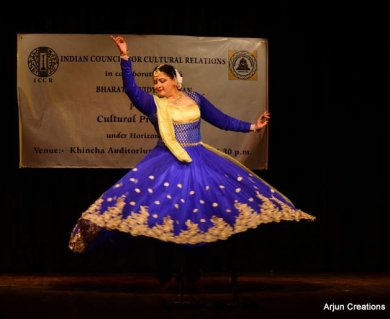
|   |

|   |
Mesmerizing Kathak by Smitha Srinivasan - Prabal Gupta e-mail: probs.gupta12@gmail.com December 22, 2015 On December 12, 2015, ICCR Bangalore organized a sparkling Kathak recital by Smitha Srinivasan, an empanelled artist of ICCR under the aegis of their Horizon Series. Rarely has one experienced such a poised solo Kathak performance so classically sound and comfortably attuned to the traditional classical genre of music. Smitha commenced her recital with a Durga Stuti. Entering the stage with gusto, the dancer’s immaculate stage presence took her performance to a superlative level. The bols were recited beautifully by Nandini Mehta in the interpretative passages “Jaya Durgae Durgati pari harini.” Neat covering of the proscenium during “Brahma saran mein aioo” looked visually appealing.  One must curtsy the dancer’s artistic handling of the pure technical aspects of Kathak with a clear delineation and padhanth before their commencement. Shama Bhate’s choreography of the technical pieces of varied time cycles each being complete with authoritative meticulousness keeping pace with grace looked brilliant. The tihai of the time cycle of 16 beats with half, one and one and half each finishing on the ‘sam’ calls for the artist’s meticulous practice over the years. While defining the tala cycle, one must appreciate the dancer’s sense of maturity for drawing a simile with Lord Krishna being the first beat and the Gopikas being the others all culminating to the macro. The series of Thaat “tata dhina dha dha dha” became an unfolding, a discovery of body and an exercise in awakening of all human senses. The prerequisites of this technique are its subtlety and power and this choreography of Guru Shame Bhate was dealt with intensely by Smitha. Amad - a Persian word etymologically meaning to come, to blossom once the thaat is accomplished with the dancer moving in slow rhythm and progressively moving onto a madhya laya post her ‘Tripati’ looked pulsating. The madhya laya started from half of the count with the second commencing after leaving two counts and concluded with pirouettes. The paran with the bols inspired from the pakhawaj were executed perfectly by the dancer. The gaat nikas choreographed by Guru Shama Bhate showing “phool ki gaat” with a lady plucking flowers, stringing and putting it on herself simultaneously admiring herself in the mirror was done with minute subtlety. The visual vocabulary showed the constant image of the maiden decorating herself beautifully. The “Mat ki gaat” with the movement congruous to a lady walking in a diagonal line with a pot brings forth a picture of a maiden carrying pot filled with water on her head. The Draupadi’s Vastraharan episode executed effortlessly by Smitha became a metaphor for the assault on women today. The ashtapadi “Sakhi he’ as taught by Bharatanatyam exponent Bragha Bessel during a workshop organized by Nadam was portrayed in the Kathak style. Neat and restrained abhinaya surfaced right from the beginning of the ashtapadi. The shy face as revealed by the dancer during the explanation of “Prathama samayama” with Krishna holding her hands looked endearing. The Gujarati bhajan “Mara Ram tanae Sitaji nae tolae na awo” choreographed by Nandini Mehta and Murali Mohan Kalva where the poet while comparing Lord Rama with Sita says that Sita occupies the highest position in terms of being worshipped as God. Though Rama is statured as god, his unacceptable behavior towards Sita by listening to others has definitely hauled him down from the superlative position. The dancer’s poised abhinaya with the vocalist Ganesh Desai’s soul stirring rendition of the interpretative passages reached a zenith moving the aficionados. The Tarana set to Jhap taal with the vocalist’s beautiful rendition of raag Bhaghesree and the dancer’s usage of stage geometry was visually appealing. Smitha moved with swanlike fluidity coupled with pulsating tatkar in a truly evocative performance with dovetailed nritta and nritya, complemented by Gurumurthy on the tabla and Narasimhamurthy on flute. Prabal Gupta is a Kathakali exponent and a disciple of Guru and research scholar Sadanam Balakrishnan. |